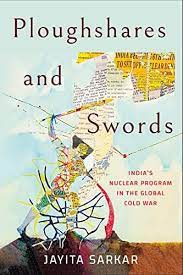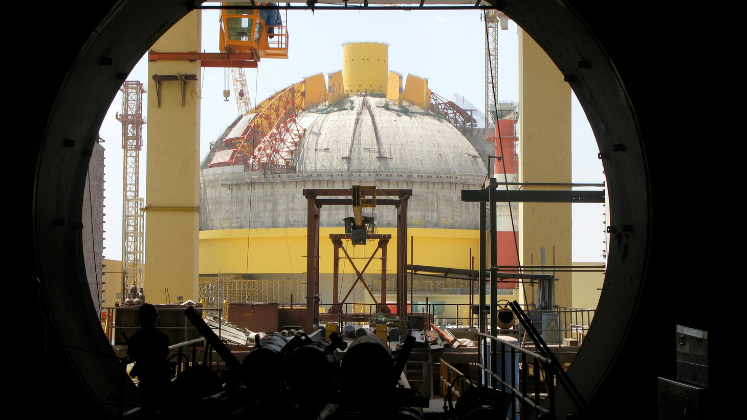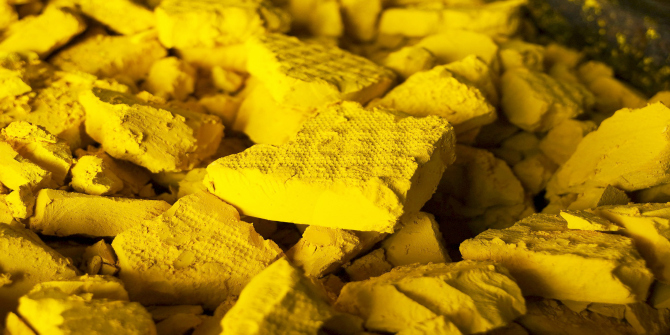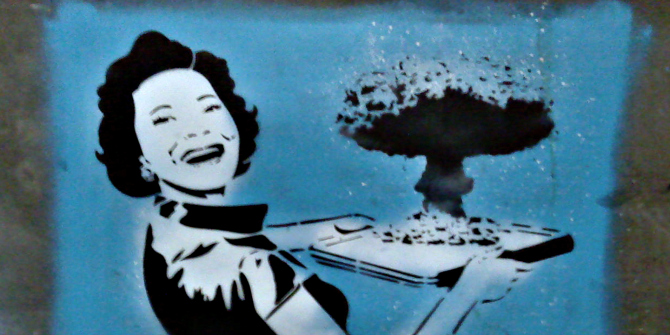In Ploughshares and Swords: India’s Nuclear Program in the Global Cold War – available open access – Jayita Sarkar explores the global story of India’s nuclear programme during its first 40 years, set within the context of the Cold War. Drawing on extensive interdisciplinary research, this book is a useful addition to the literature on India’s nuclear programme and powerfully underscores the importance of its subject matter, writes M.V. Ramana.
This book review has been translated into Mandarin by Do Yun Gim (金度潤) (LN814, teacher Dr Lijing Shi) as part of the LSE Reviews in Translation project, a collaboration between LSE Language Centre and LSE Review of Books. Please scroll down to read this translation or click here.
Ploughshares and Swords: India’s Nuclear Program in the Global Cold War. Jayita Sarkar. Cornell University Press. 2022.

Ever since the May 1998 nuclear weapon tests conducted by India, and followed by Pakistan, there has been a stream of books and articles that delve into the history of the nuclear programmes of the two South Asian countries. Possessing a larger and older nuclear programme, India has come in for more attention. Of special importance are books by scholars Itty Abraham, Robert Anderson, George Perkovich, and Jahnavi Phalkey.
Jayita Sarkar’s Ploughshares and Swords follows in this tradition to dive deeper into the same saga, placing this history within the larger context of the Cold War. The book makes two key points: firstly, India’s nuclear programme was a result of close collaboration, knowledge assimilation and technological imports from many countries, chiefly France, the US, the UK and the Soviet Union. Secondly, India’s nuclear programme was ‘a dual-use endeavour, simultaneously serving civilian and military ends’ (7-8). Sarkar also offers a third argument about the space programme, but, in my opinion, it is less central to the book.
Both of these main points should be fairly uncontroversial. But they might not be, especially to those who have believed the propaganda offered by India’s official establishment about its entirely indigenous and independent technological capabilities or by the global nuclear industry about a clear distinction between civilian nuclear energy and nuclear weapons production. (Just for emphasis: there isn’t a clear distinction. Building the infrastructure for generating nuclear energy will take a country part of the way toward making nuclear weapons. Whether a country does so or not is largely a matter of choice, not capacity.) These arguments are particularly important today as advocates of nuclear power make historically flawed arguments about the technology, and play up its supposed ability to solve the grave threat of climate change.

Image Credit: ‘04710082’ by IAEA Imagebank (Kirstie Hansen/IAEA) licensed under CC BY SA 2.0
Ploughshares and Swords is chronological in its organisation, starting with the 1940s and the global interest in rare earths, specifically in the monazite sands found in the kingdom of Travancore, before its accession to India. After recounting the institutional birth of India’s nuclear programme, Sarkar describes the close cooperation between France and India’s atomic energy institutions, and India’s leadership playing off the US and the Communist bloc.
The next section opens with US President Dwight Eisenhower’s ‘Atoms for Peace’ speech that inaugurated a global nuclear marketplace, going on to describe how India’s Department of Atomic Energy (DAE) signed agreements with the UK and Canada for its first two reactors, Apsara and CIRUS.
Most critical to India’s nascent interest in nuclear weapons was the 1959 purchase of the designs for a reprocessing plant from the US Vitro Corporation. This plant was to separate plutonium from the other radioactive and undesirable elements in the spent fuel that would be forthcoming from the yet-to-be constructed CIRUS reactor, plutonium that would be first used to make the nuclear device exploded in May 1974. Among the important steps toward that explosion, Sarkar describes in some detail how the DAE obtained the design of a fast neutron reactor called PURNIMA which was built on the basis of the design of the Soviet Union’s IBR-30 reactor. That reactor was to allow DAE physicists to figure out the behaviour of neutrons in the core of a nuclear weapon in the early stages of its explosion.
The third section of the book is set in the 1970s when India’s Prime Minister Indira Gandhi ordered the first nuclear test, and the narrative alternates between domestic developments and the foreign policy and regional security environment. For the latter, in addition to describing the overall architecture of the global system of nation states that was being fractured on many fronts, Sarkar focuses on the events that led to the partition of Pakistan and Bangladesh becoming a separate nation state, and India’s annexation of Sikkim.
Ploughshares and Swords, simply by virtue of being written much later, recounts a familiar story. But in each of these sections, it offers new archival evidence, assembled from collections housed in eight countries. Some of these nuggets are indeed very interesting. I will offer one teaser here. In June 1974, during a meeting with the secretary general of the French Ministry of Foreign Affairs, the Indian ambassador to France apparently claimed that the Indian government had been ‘ready for an underground nuclear explosion since 1967’ but delayed it ‘owing to circumstances’ (122). If true, this would change our understanding of when India acquired the technical capacity to design a nuclear weapon.
I will add that I find this quite implausible for a couple of reasons. First, as Sarkar writes a few pages later (126-28), before designing the explosive device, DAE physicists needed to experiment with the PURNIMA reactor, which was approved only in late 1968. Second, Ashok Parthasarathi revealed in his 2007 autobiographical account of his years as Prime Minister Indira Gandhi’s science and technology adviser that the first reprocessing plant ‘failed to work properly for almost seven years after formal commissioning. The chief problem was the separation of plutonium from the fission products. The concentration of the latter in the final product continued to be too high for the material to be handled and used for any purpose’ (17).
There are a couple of places in the book where the author — a historian by training — might have benefitted from having her manuscript whetted by someone more knowledgeable about nuclear science and technology. One example is the description of the US interest in selling a Light Water Reactor ‘because it did not produce plutonium’ (81). Doubtlessly, Sarkar is accurately summarising some official document, but this is technically just wrong. Light Water Reactors, too, produce plutonium, and this plutonium is usable in nuclear weapons, even if it might be, for technical reasons, less desirable when compared to plutonium from a reactor like CIRUS that operates with natural uranium.
Minor quibbles aside, Ploughshares and Swords is a useful addition to the literature on India’s nuclear weapon/energy programme. Based on extensive research, the book brings together scholarship from diverse disciplines. Sarkar subtly emphasises the importance of understanding the subject of this research through a brief but powerful epilogue. Sarkar highlights how India’s nuclear programme has become an ‘anti-dissent machine’, acting as a ‘disciplining device of the state’ and unleashing violence against citizens who have agitated against nuclear power plants, thus sustaining ‘an antidemocratic culture in the largest democracy in the world’ (202-204). To quote from The End of Imagination, novelist Arundhati Roy’s moving essay written after the 1998 nuclear test, the ‘nuclear bomb is the most anti-democratic, anti-national, anti-human, outright evil thing that man has ever made’.
Note: This review gives the views of the author, and not the position of the LSE Review of Books blog, or of the London School of Economics and Political Science.
 在1998 年 5 月的印度和随后巴基斯坦的核武器试验以后,有很多讨论这两个南亚国家的核计划历史的书籍和文章很多。因为印度的核计划比巴基斯坦更大历史也更悠久,因此关于印度的核计划历史研究更受关注。而学者Itty Abraham, Robert Anderson, George Perkovich, 和Jahnavi Phalkey写的著作尤为重要。
在1998 年 5 月的印度和随后巴基斯坦的核武器试验以后,有很多讨论这两个南亚国家的核计划历史的书籍和文章很多。因为印度的核计划比巴基斯坦更大历史也更悠久,因此关于印度的核计划历史研究更受关注。而学者Itty Abraham, Robert Anderson, George Perkovich, 和Jahnavi Phalkey写的著作尤为重要。
Jayita Sarkar 的《犁铧与剑》遵循这种传统,深入探讨同一个故事,将这段历史置于冷战的背景下。 这本书提出两个要点:首先,印度的核计划是与许多国家(主要是法国、美国、英国和苏联)密切合作,吸收知识,引进技术的结果。 其次,印度的核计划是“一项双重用途的努力,同时服务于民用和军事目的”(7-8页)。 Sarkar 还提出了关于太空计划的第三个论点,但我认为,它在本书中没那么重要。
这两个要点应该是没有争议的。但是对于那些相信印度官方关于自己的完全自主和独立的技术能力或全球核工业关于民用原子能和核武器生产之间有明确区别宣传的人来说,可能并不如此。(特别强调:这两者之间的区别并不明显。建立核能基础设施将在某种程度上促使一个国家发展核武器。而一个国家是否会这样做,起关键作用的不是能力,更重要的是选择。) 这些主张在今天尤其重要,因为原子能拥护者对该技术持有历史缺陷的观点,并且夸大了原子能的在解决气候变化威胁方面的能力。

《犁铧与剑》按时间顺序组织,从 1940 年代和全球对稀土的兴趣开始,特别是在特拉凡科王国(在其归属印度之前)发现独居石砂的时候。 在讲述了印度核计划的体制诞生之后,Sarkar描述了法国和印度原子能机构之间的密切合作,以及印度领导层与美国和共产主义集团的较量。
下一节以美国总统艾森豪威尔开创全球核市场的《原子促进和平》的演讲开始,接着介绍了印度原子能部 (DAE) 如何与英国和加拿大签署最早两个反应堆 Apsara 和CIRUS的协议。
1959 年从美国 Vitro 公司购买了后处理厂的设计是印度对核武器的初创期最关键的兴趣点。 该工厂旨在将钚与即将从尚还没建造的 CIRUS 反应堆中产生的乏燃料中的其他放射性和不良元素分离,钚将首先用于制造核装置,该核装置于 1974 年 5 月爆炸。 关于那次爆炸的重要步骤中,Sarkar 详细描述了 DAE 如何获得名为 PURNIMA 的快中子反应堆的设计 — 该反应堆是在苏联 IBR-30 反应堆设计的基础上建造的,旨在让 DAE 物理学家弄清楚核武器爆炸早期阶段中子在核武器核心中的行为。
该书第三部分的背景是 1970 年代印度总理英迪拉甘地命令进行首次核试验。其叙述在国内发展与外交政策和地区安全环境之间轮流进行。 对于后者,除了解释在多方面瓦解的民族国家全全球体系之外,Sarkar还重点关注导致巴基斯坦和孟加拉国分裂成为独立民族国家,以及印度吞并锡金。
《犁铧与剑》,得益于写得晚,重述了一个熟悉的故事。 但在每个部分中,它都提供了新的档案证据,这些证据来自八个国家的“宝藏”。 其中一些片段确实非常有趣。 我在这里稍微“剧透”一下。 1974 年 6 月,在与法国外交部秘书长会面时,印度驻法国大使显然主张印度政府 “从 1967 年就已准备好进行地下核爆炸”,但“因情况”推迟了(122页)。如果这个细节属实,将可能改变我们对印度何时获得设计核武器技术能力的理解。
我还要补充我觉得一些值得怀疑的因素。 首先,正如 Sarkar 在数页之后 (126-28页) 所写,在设计爆炸装置之前,DAE 物理学家需要使用1968 年底才获得批准的PURNIMA 反应堆进行实验。其次,Ashok Parthasarathi 在他 2007 年的自传中透露了 在他担任英迪拉·甘地总理的科技顾问的时候,第一座后处理厂“在正式开动后将近七年没正常工作”。 主要问题是从裂变产物中分离钚。 最终产品中的钚浓度仍然过高,无法处理和用于任何目的的材料”(17页)。
在书里面有几个点,历史学家出身的作者可能会受益于更了解核科学和技术的人对她的原稿的润色。 一个例子是关于美国对出售轻水反应堆的兴趣的兴趣的讲述,“因为它不生产钚” (81页)。 毫无疑问,Sarkar准确地总结了一些官方文件,但从技术上讲是错的。 轻水反应堆也会产生钚,与来自像 CIRUS 这样使用天然铀运行的反应堆产生的钚相比,即使出于技术原因可能不太理想,这种钚仍然可用于核武器。
暂且不谈小问题,《犁铧与剑》是对印度核武器/能源计划文献的有益补充。 基于广泛的研究,这本书汇集了来自不同学科的研究学问。 Sarkar通过简短而有力的结语巧妙地强调了理解本研究主题的重要性。 Sarkar 强调了印度的核计划如何成为“反异议的机器”,充当“国家的纪律工具”并对鼓动反对核电厂的公民发动暴力,从而在“最大的民主国家(印度)”维持“反民主文化”(202-204页)。 引用小说家Arundhati Roy在 1998 年核试验后写的感人文章《想象的终结》中的话,“核弹是人类历史以来最反民主、反国家、反人类的邪恶事物”。








Author Response by Jayita Sarkar, May 2023
Physicist M.V. Ramana wrote a short review of Ploughshares and Swords for LSE Review of Books in October 2022. Having learned a fair amount over the years from Ramana’s many writings, it was an honour to have him publicly evaluate my work. His assessment, however, did not accurately reflect the book’s arguments and evidence, prompting this response.
Ploughshares and Swords is a work of history that straddles multiple historiographical worlds— of decolonisation, diplomacy, politics and technology— within transnational and international frames. Ramana characterises the book as the outcome of `interdisciplinary research’ about the ‘same saga’ that ‘recounts a familiar story’. These characterisations seem inappropriate given the book’s sources and methods, when contrasted against the thin historiography of post-1947 South Asia generally and archive-based histories of India’s nuclear and space programmes specifically.
Without explanation he amplifies aspects of the book while ignoring others, such as India’s space programme. He writes, ‘In my opinion, it is less central to the book.’ Why? The space programme, which is the second focus of the book, directly connects to its overarching theme of the concurrent pursuit of civilian and military technologies as well as the third key argument about territoriality and geopolitics.
He probes the book to know ‘when India acquired the technical capacity to design a nuclear weapon’, and finds Indian Ambassador D.N. Chatterjee’s remark to French policymakers about the Indian government being ‘ready for an underground nuclear explosion since 1967’ ‘implausible’. This overlooks the technopolitics of nuclear things. The deliberate ambiguity between civilian and military dimensions of nuclear technologies, I argue, allowed space for political manoeuvring by India’s political and technocratic leaders, including seasoned diplomats such as Chatterjee. Citing a practitioner’s autobiographical account of the malfunctioning of India’s plutonium reprocessing plant, he concludes that the plant was insignificant from the point of view of nuclear proliferation, which overlooks the politics of nuclear latency.
Over the past two decades, extensive declassification of national, international and private archives concerning the period after formal decolonisation of South Asia has created new intellectual opportunities for trained historians. Subject matters that were once the turf of journalists, retired technocrats and policymakers have witnessed fresh evaluations by historians. Heeding Tony Smith’s admonition to avoid ‘orthodoxy plus archives’, this new generation has been pouring new wine in new bottles (see for example, here, here, here, here and here). It is important to not miss this intellectual shift. After all, yesterday’s burning issues become the historian’s inquiry today.